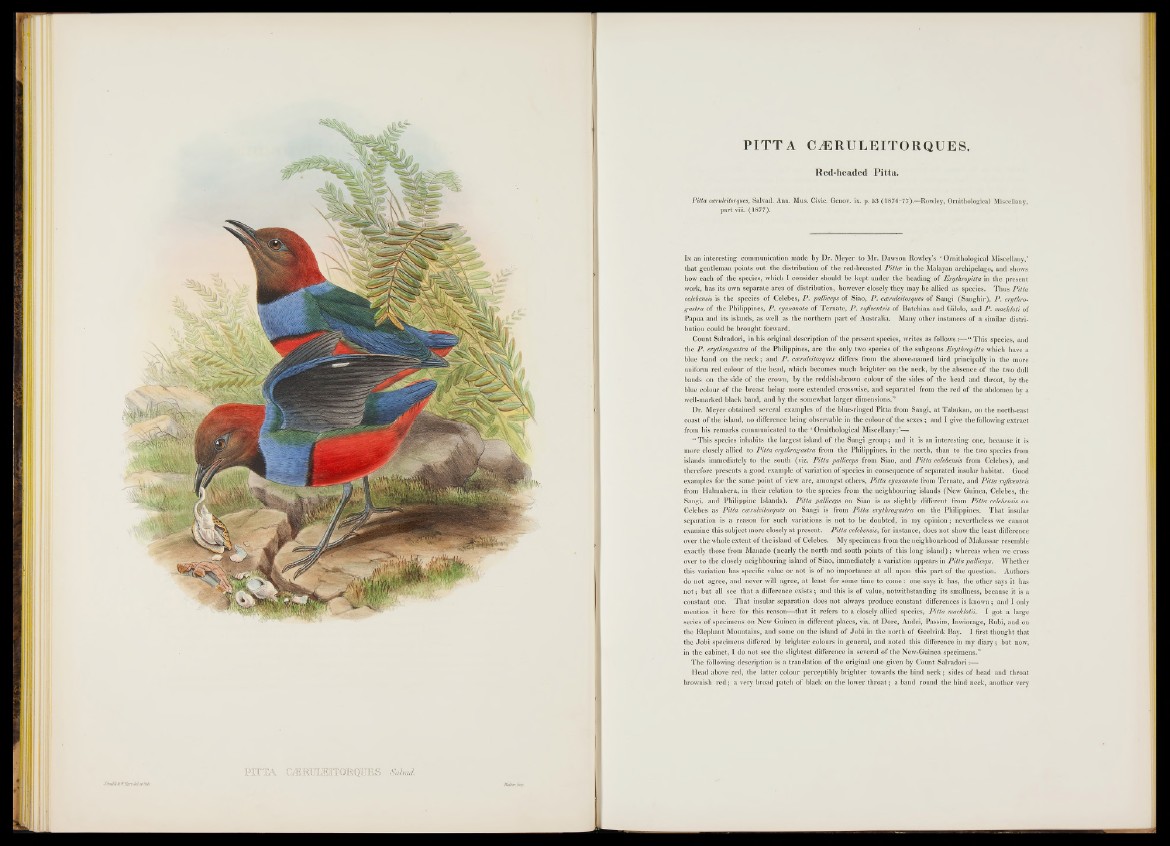
POTA. CuEBUHEITOttCpE S S a lva i
WitterJnq/.
PITTA CCERULEITORQUES.
Red-headed Pitta.
Pitta cceruleitorques, Salvad. Ann. Mus. Civic. Genov, ix. p. 53 (1876-77).—Rowley, Ornithological Miscellany,
p art viii. (1877).
I n an interesting communication made by Dr. Meyer to Mr. Dawson Rowley’s ‘ Ornithological Miscellany,’
that gentleman points out the distribution o f the red-breasted P itta in the Malayan archipelago, and shows
how each of the species, which I consider should be kept under the heading o f Erythropitta in the present
work, has its own separate area o f distribution, however closely they may be allied as species. Thus Pitta
celebensis is the species o f Celebes, P. palliceps of Siao, P. cceruleitorques o f Sangi (Sanghir), P. erythro-
gastra o f the Philippines, P. cyanonota of Ternate, P. rufiventris of Batchian and Gilolo, and P. mackloti of
Papua and its islands, as well as the northern p art o f Australia. Many other instances of a similar distribution
could be brought forward.
Count Salvadori, in his original description of the present species, writes as follows :— “ T his species, and
the P. erythrogastra o f the Philippines, are the only two species o f the subgenus Erythropitta which have a
blue band on the n e ck ; and P. cceruleitorques differs from the above-named bird principally in the more
uniform red colour o f the head, which becomes much brighter on the neck, by the absence of the two dull
bands on the side o f the crown, by the reddish-brown colour o f the sides o f the head and throat, by the
blue colour o f the breast being more extended crosswise, and separated from the red o f the abdomen by a
well-marked black band, and by the somewhat larger dimensions.”
Dr. Meyer obtained several examples of the blue-ringed Pitta from Sangi, a t Tabukan, on the north-east
coast o f the island, no difference being observable in the colour o f the sexes; and I give the following extract
from his remarks communicated to the ‘ Ornithological Miscellany:’—
“ This species inhabits the largest island o f the Sangi g ro u p ; and it is an interesting one, because it is
more closely allied to Pitta erythrogastra from the Philippines, in the north, than to the two species from
islands immediately to the south (viz. Pitta palliceps from Siao, and Pitta celebensis from Celebes), and
therefore presents a good example o f variation o f species in consequence o f separated insular habitat. Good
examples for the same point of view are, amongst others, Pitta cyanonota from Ternate, and Pitta rufventris
from Halmahera, in their relation to the species from the neighbouring islands (New Guinea, Celebes, the
Sangi, and Philippine Islands). Pitta palliceps on Siao is as slightly different from Pitta celebensis on
Celebes as Pitta cceruleitorques on Sangi is from Pitta erythrogastra on the Philippines. T h a t insular
separation is a reason for such variations is not to be doubted, in my opinion; nevertheless we cannot
examine this subject more closely at present. Pitta celebensis, for instance, does not show the least difference
over the whole extent o f the island o f Celebes. My specimens from the neighbourhood o f Makassar resemble
exactly those from Manado (nearly the north and south points of this long isla n d ); whereas when we cross
over to the closely neighbouring island o f Siao, immediately a variation appears in Pitta palliceps. Whether
this variation has specific value o r not is o f no importance at all upon this p art o f the question. Authors
do not agree, and never will agree, at least for some time to come: one says it has, the other says it has
n o t ; but all see th at a difference ex ists; and this is o f value, notwithstanding its smallness, because it is a
constant one. T h a t insular separation does not always produce constant differences is known; and I only
mention it here for this reason— that it refers to a closely allied species, Pitta macklotii. I got a large
series o f specimens on New Guinea in different places, viz. a t Dore, Andei, Passim, Inwiorage, Rubi, and on
the Elephant Mountains, and some on the island o f Jo b i in the north of Geelvink Bay. I first thought that
the Jo b i specimens differed by brighter colours in general, and noted this difference iu my d iary ; but now,
in the cabinet, I do not see the slightest difference in several o f the New-Guinea specimens.”
The following description is a translation o f the original one given by Count Salvadori
Head above red, the latter colour perceptibly brighter towards the hind n e c k ; sides o f head and throat
brownish r e d ; a very broad patch of black on the lower th ro a t; a band round the hind neck, another very